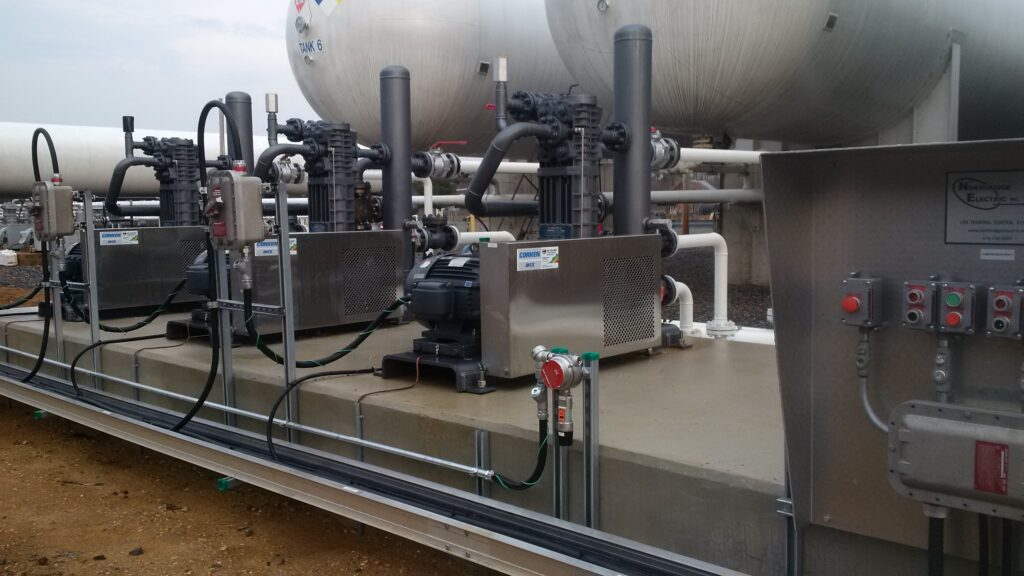Propane terminal design and NGL terminal safety require automated safeguards, remote monitoring, and integrated emergency shutdowns to prevent accidents. Northridge provides advanced terminal-management systems that detect hazards, automate responses, and ensure compliance with industry regulations. Below are some real-world scenarios where a Northridge solution could have or did save lives, protect assets, and prevent costly downtime.
A driver arrived at a Northridge-equipped terminal on a Friday afternoon for an urgent fill request. He could not operate the transfer pump, and the nearest technician was four hours away.
Using remote system access, Northridge’s help desk logged in to the terminal management system and identified that a control station had frozen. Within 15 minutes, we were able to remotely override the frozen switch, allowing the driver to complete his load. Additionally, our system documentation and inventory tracking enabled us to ship the necessary replacement parts for Monday repairs, preventing unnecessary downtime.
A driver was loading his bulk trailer and left to use the washroom. While he was absent, a 4-inch transfer hose split, releasing thousands of gallons of propane vapor into the facility. By the time he returned, the entire site was knee-deep in gas. Though he escaped, the vapor found an ignition source, triggering an explosion. A 30,000-USWG tank BLEVE’d, destroying the facility and a portion of the surrounding neighborhood, tragically killing one person.
A Northridge terminal-management system would have prevented this tragedy with a driver-attendance monitor that pauses transfers when the operator leaves the station. Gas leak detection would have triggered automatic shutdowns before dangerous levels of vapor accumulated, preventing ignition.
An aging facility relied on manual ISC-valve operation using fire links and cables. A driver forgot to close the terminal’s ISC valves before leaving for the night. Overnight, a heavy frost caused pipe supports to shift, cracking a pipe and allowing liquid propane to leak into the surrounding valley. The flow rate was too low to trigger automatic ISC closure, and the entire site filled with propane vapor. The next morning, an arriving operator recognized the danger, shut off his truck, and manually closed the valve—risking his life to prevent a disaster.
A Northridge control system would have used integrated valve actuators to automatically close the ISC valves when no activity was detected. Automated valve closure upon inactivity would have shut down the system overnight, preventing the propane release entirely.
A vapor compressor was left idle overnight, allowing the cool night air to condense vapor in the lines. The next morning, an operator started the compressor without checking the liquid trap, pulling liquid into the compressor head and causing catastrophic failure. The damage required costly repairs and extensive downtime.
A Northridge automation system would have detected liquid in the system before startup, using liquid, pressure, and temperature sensors with interlocking controls to prevent compressor activation. Heat tracing on condensate lines and a pump-down control system would have kept the lines clear. Additionally, an elapsed-time meter on the dashboard would have tracked runtime, signaling when maintenance was required to prevent equipment damage.
A manifolded tank system consistently filled unevenly, leading operators to manually check levels using rotary gauges. To prevent overfilling, operators closed valves manually, but on one occasion, an operator was distracted during the process, resulting in an overfilled tank and a site shutdown. Additionally, the site lacked a real-time tank-level monitoring system, forcing operators to physically check levels or rely on a costly cellular polling system.
With electronic tank gauging, each tank inlet would have automatically closed at 85% capacity, preventing overfills and unnecessary manual intervention. Automated equalization would have balanced tanks at the end of each shift. A remote-level display would have given operators real-time, aggregated volume readings without polling costs. Run-dry protection for pumps would have added an extra layer of safety.
An older propane terminal relied on manual pneumatic switches for tank valves and pumps. The only safety controls were an emergency stop button and a nitrogen-driven air horn mounted on a wall. When a loading hose split, the driver hit the emergency stop, shutting off the pump—but not closing the tank valves. He then ran to the air horn to alert the office, but by that time, the yard was full of propane vapor, forcing another operator to risk his life to manually shut the valves.
A Northridge control system would have automated the emergency-stop process, simultaneously shutting down all motors, closing all tank valves, and triggering audible and visual alarms while notifying management via real-time alerts. Multiple e-stops would have been strategically placed, allowing for an immediate response from any point in the facility. Hydrocarbon leak detection and electronic pressure sensing would have ensured automatic shutdown before the situation escalated.
These incidents highlight the critical need for automated propane terminal safety solutions. Our propane terminal management systems allow for advanced monitoring, automated emergency response, and real-time remote access, reducing the likelihood of catastrophic failures.
Northridge solutions integrate:
